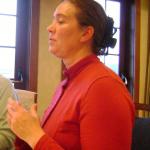Group A, Poster #189, Stress and Deformation Over Time (SDOT)
Advances in understanding the late Quaternary activity and post-Miocene slip history of the northwestern “Palomas” Section of the San Gabriel Fault, Black Mountain and Alamo Mountain 7.5’ quadrangles, southern California
Poster Image:

Poster Presentation
2022 SCEC Annual Meeting, Poster #189, SCEC Contribution #12381 VIEW PDF
Late Miocene, large-scale, oblique right-lateral slip is well documented along the San Gabriel Fault (SGF); however, the style, magnitude and timing of later movement varies along strike and has been the subject of debate. New studies near Pyramid Lake implement Infrared Stimulated Luminescence (IRSL) dating to constrain the age of latest surface rupture and updated mapping to characterize the slip sense and magnitude of Pliocene to late Quaternary movement along two strands of the northwestern portion of the fault. Dating of old alluvial deposits (Qoa) at Hardluck Canyon suggest the last rupture event on the Hardluck strand of the fault occurred prior to about 18.3 ka but is unconstrained on the Piru strand. At Beartrap Canyon, SW of Pyramid Lake, a large landslide failed to the NE across the SGF, burying Qoa dated at 23.1 ka in the canyon bottom and possibly ponding alluvium (Qopa) along the fault to the NW. High resolution lidar and imagery suggest that both the landslide and Qopa were offset by subsequent movement on both fault strands. Field observations at a bluff above the Smith Fork of Piru Creek revealed that Qoa (ranging in age from 55.93 +/-4.30 ka near the base to 49.29 +/-2.67 ka near the top) has been offset at an apparent right-step in the fault zone. The largest displacement shows 6 m of vertical separation and 15° plunging striations were locally observed, suggesting up to 23.2 m of right-lateral oblique slip; resulting late Quaternary slip rates range from 0.11 to 0.47 mm/yr for vertical and oblique components, respectively. From a long-term-slip perspective, diagnostic red beds in a lower member of the Pliocene Hungry Valley Fm are displaced about 1 km right-laterally across the SGF. Distinctive landslide debris composed largely of gabbro (Tlga) was identified on the NE side of the SGF interleaved with late Miocene Violin Breccia (Tvb). Correlation with the likely gabbro source SW of the fault suggests the Tlga has been offset about 3 km right laterally to exposures NE of the Piru strand, and an additional 5 km to exposures NE of the Hardluck strand. Rare tuff beds exposed south of both Tlga deposits support a similar 5 km displacement. Evidence of tight folding and repetition of Tvb along the Hardluck strand suggests a change from transtensional to transpressional oblique right slip, which may correspond to development of the Mojave strand of the San Andreas Fault.













